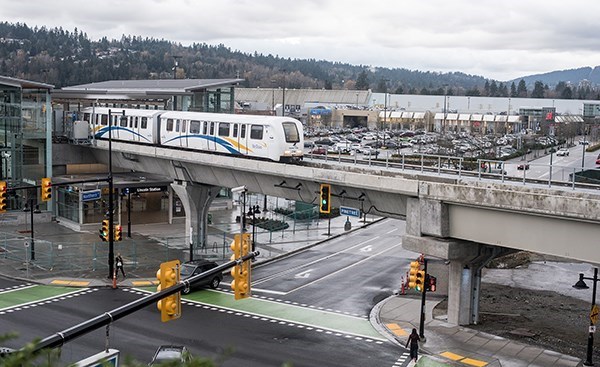Wider sidewalks, more street lighting, trees and benches, and a lane for e-bikes and e-scooters is on the horizon for Coquitlam City Centre.
City hall is looking to make the neighbourhood more walkable and safe as it readies the area to become a vibrant downtown with 50 more towers, an entertainment district and business core.
The proposed streetscape guidelines are set to be presented to city council this fall — with a public hearing to follow — aiming to shape City Centre into a modern place with an expected 24,000 more residents over the next 25 years.
Forming part of the City Centre Area Plan (CCAP) update, which council OK’d in November 2020, the streetscape guidelines would apply, in general, from the Coquitlam Central to Lafarge Lake–Douglas stations along the Millennium Line, and between Johnson and Westwood streets; a downtown promenade would run through the Coquitlam Centre mall campus, south of The High Street.
Under the plan, the streetscape improvements would be based on three principles:
- Movement
- Prioritizing universal accessibility, public safety, a pedestrian-friendly environment and active modes of transportation
- Environment
- Enhancing natural areas and access to nature, and showing environmental sustainability
- Urban design
- Supporting business and economic development, as well as the area’s civic and cultural hubs
"The focus here is on creating attractive destinations to attract and draw people to the streets and public spaces," said city planner Payvand Razaghizad as she presented the 96-page draft report to committee-in-council on June 20.
Urban streets
In a nutshell, the guidelines look at the public space between the building and the curb in the high-density residential and commercial zones of City Centre.
For a commercial/residential frontage, for example, the space after a private or public property line would have the following elements:
- Sidewalk
- Boulevard lane
- Micro-mobility lane
- Buffer lane
- Curb
- Street
Pavers and street trees would go in the boulevard and buffer lanes; however, they would not be installed on sidewalks or micro-mobility lanes; those would be flat and paved with asphalt, Razaghizad said.
Andrew Merrill, Coquitlam’s director of development services, said city staff will also be working with developers of new buildings to provide continuous canopies along City Centre sidewalks to protect pedestrians.
"Uniform is better from a design standpoint," Coun. Craig Hodge said.
Coun. Steve Kim said in Seoul, South Korea, the government has fixed street umbrellas that pedestrians can wind up to shield them from the sun or rain.
Coun. Chris Wilson said he'd also like to see more public art in the neighbourhood, such as the handpainted salmon sculptures that dot the city.
And Coun. Teri Towner said she anticipates micro-mobility vehicles like e-scooter, e-bikes and e-unicycles will surge in popularity.
Besides the draft City Centre Streetscape Guidelines, city staff also plan to present an Official Community Plan (OCP) change before council this fall to include micromobility in the CCAP.





